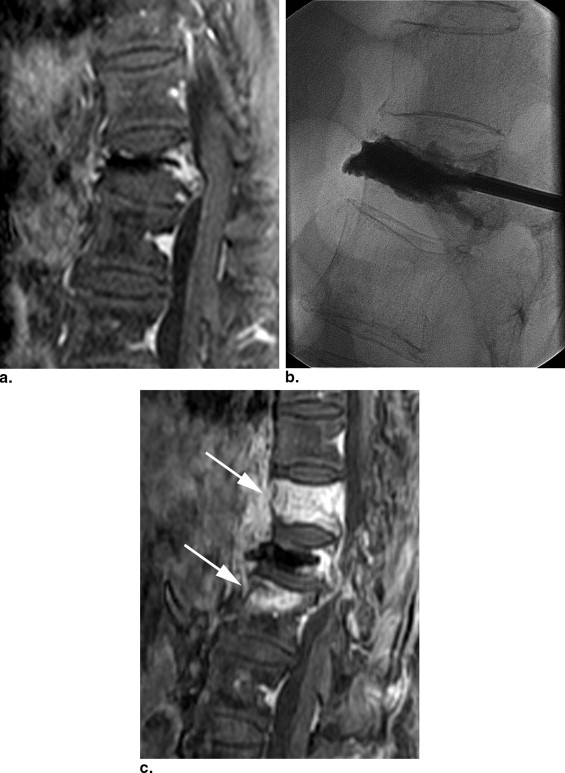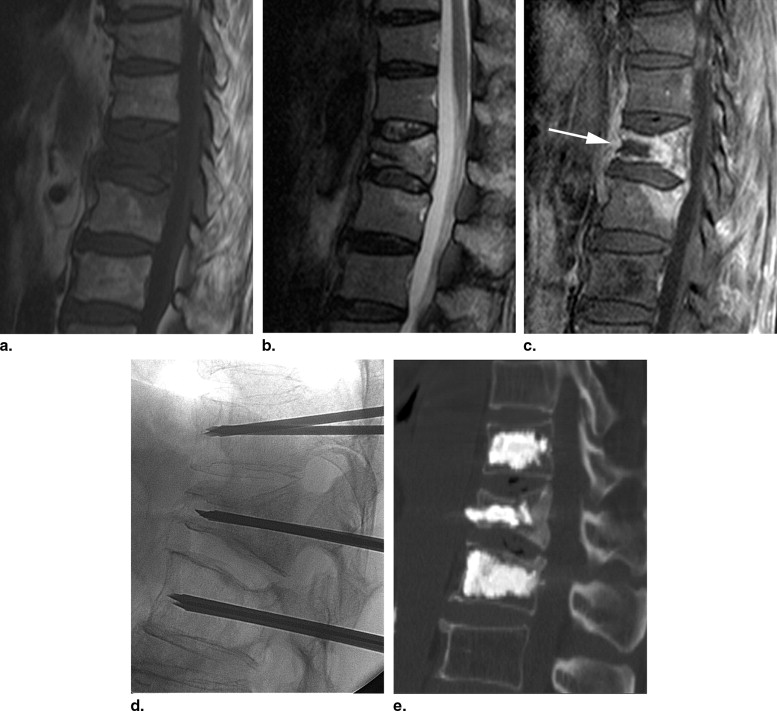Rationale and Objectives
We investigated the efficacy of prophylactic cement injection into the vertebral body adjacent to fractured vertebra to prevent new fractures after percutaneous vertebroplasty (PV).
Materials and Methods
Between February 2002 to August 2004, PV was performed for osteoporotic compression fractures in 89 consecutive patients. All patients underwent PV for only fractured vertebrae. Between September 2004 and October 2006, we performed prophylactic cement injection for 155 patients, with cement injected into the non-fractured vertebra adjacent to the fractured vertebra, immediately above the fractured vertebra in the same procedure. We evaluated the frequency of new vertebral fractures and the efficacy of prophylactic therapy.
Results
In the non-prophylactic group, 15 of 89 patients (16.8%) developed new fractures within 3 months and 20 of 89 patients (22.4%) developed new painful compression fractures within a year after the first PV. These fractures occurred mostly in adjacent vertebra, particularly in the vertebra immediately superior to the treated one and occurred in the lower thoracic and upper lumbar spine. In the prophylactic group, 7 of 155 patients (4.5%) developed new compression fractures within 3 months and 15 of 155 patients (9.7%) developed new compression fractures within 1 year. Statistical analysis showed that fewer new fractures developed in the prophylactic group than in the non-prophylactic group at both 3 months ( P = .0020, Fisher’s exact test) and 1 year ( P = .0079).
Conclusions
Prophylactic cement injection into non-fractured vertebrae adjacent to fractured vertebrae may prevent new compression fractures after vertebroplasty for osteoporotic patients.
The first report of percutaneous vertebroplasty (PV) was published in 1987 by Galibert et al, who treated a patient with a giant angioma in the second cervical vertebra ( ). Ever since, PV has been performed all over the world for tumor or osteoporosis-related compression fractures, particularly spinal compression fractures with difficult pain control. Many studies have demonstrated the therapeutic effects and complications of PV ( ). In particular, PV is a highly effective and quick-responding measure against acute and subacute spinal compression fractures, and is effective in relieving pain from prolonged therapy due to pseudoarthrosis ( ).
Even if PV improves the activities of daily living and sufficiently relieves pain, new spinal compression fractures often occur soon after therapy, causing back pain to recur. Because of recurrent painful compression fractures, second or multiple treatments are sometimes needed ( ).
Get Radiology Tree app to read full this article<
Get Radiology Tree app to read full this article<
Materials and methods
Subjects
Get Radiology Tree app to read full this article<
Get Radiology Tree app to read full this article<
PV Procedures
Get Radiology Tree app to read full this article<
Get Radiology Tree app to read full this article<
Analysis
Get Radiology Tree app to read full this article<
Get Radiology Tree app to read full this article<
Get Radiology Tree app to read full this article<
Results
Get Radiology Tree app to read full this article<
Get Radiology Tree app to read full this article<
Get Radiology Tree app to read full this article<
Get Radiology Tree app to read full this article<
Get Radiology Tree app to read full this article<
Get Radiology Tree app to read full this article<
Get Radiology Tree app to read full this article<
Get Radiology Tree app to read full this article<
Table 1
Statistical Analysis (Fisher’s exact test)
New Fracture Within 3 Months ( n = 244) New Fracture Within a Year ( n = 244) Non-prophylactic group 15/89 (16.8%) 20/89 (22.4%) Prophylactic group 7/155 (4.5%) 15/155 (9.7%)P value .0020 .0079 Relative risk 0.27 (0.11–0.63) 0.43 (0.23–0.80)
Get Radiology Tree app to read full this article<
Discussion
Get Radiology Tree app to read full this article<
Get Radiology Tree app to read full this article<
Get Radiology Tree app to read full this article<
Get Radiology Tree app to read full this article<
Get Radiology Tree app to read full this article<
Get Radiology Tree app to read full this article<
Get Radiology Tree app to read full this article<
Get Radiology Tree app to read full this article<
Get Radiology Tree app to read full this article<
Get Radiology Tree app to read full this article<
Get Radiology Tree app to read full this article<
Get Radiology Tree app to read full this article<
Conclusion
Get Radiology Tree app to read full this article<
Acknowledgments
Get Radiology Tree app to read full this article<
References
1. Galibert P., Deramond H., Rosat P., et. al.: Preliminary note on the treatment of vertebral angioma by percutaneous acrylic vertebroplasty [in French]. Neurochirurgie 1987; 33: pp. 166-168.
2. Lapras C., Dusquenel J.: [Percutaneous injection of methylmethacrylate in osteoporosis and severe vertebral osteolysis (Galibert’s technique)]. Ann Chir 1989; 43: pp. 371-376.
3. Heini P.F., Walchli B., Berlemann U.: Percutaneous transpedicular vertebroplasty with PMMA: operative technique and early results. Eur Spine J 2000; 9: pp. 445-450.
4. Kallmes D.F., Jensen M.E.: Percutaneous vertebroplasty. Radiology 2003; 229: pp. 27-36.
5. Evans A.J., Jensen M.E., Kip K.E., et. al.: Vertebral compression fractures: pain reduction and improvement in functional mobility after percutaneous polymethylmethacrylate vertebroplasty—retrospective report of 245 case. Radiology 2003; 226: pp. 366-372.
6. Mckiernan F., Faciszewski T., Jensen R.: Quality of life following vertebroplasty. J Bone Joint Surg Am 2004; 86: pp. 2600-2606.
7. Grados F., Depriester C., Cayrolle G., et. al.: Long-term observations of vertebral osteoporotic fractures treated by percutaneous vertebroplasty. Rheumatology (Oxford) 2000; 39: pp. 1410-1414.
8. Layton K.F., Thielen K.R., Koch C.A., et. al.: Vertebroplasty, first 1000 levels of a single center: evaluation of the outcomes and complications. AJNR Am J Neuroradiol 2007; 28: pp. 683-689.
9. Brown D.B., Gilula L.A., Sehgal M., et. al.: Treatment of chronic symptomatic vertebral compression fractures with percutaneous vertebroplasty. AJR Am J Roentgenol 2004; 182: pp. 319-322.
10. Irani F.G., Morales J.P., Sabharwal T., et. al.: Successful treatment of a chronic post-traumatic 5-year-old osteoporotic vertebral compression fracture by percutaneous vertebroplasty. Br J Radiol 2005; 78: pp. 261-264.
11. Uppin A.A., Hirsch J.A., Centenera L.V., et. al.: Occurrence of new vertebral body fracture after percutaneous vertebroplasty in patients with osteoporosis. Radiology 2003; 226: pp. 119-124.
12. Syed M.I., Patel N.A., Jan S., et. al.: New symptomatic vertebral compression fractures within a year following vertebroplasty in osteoporotic women. AJNR Am J Neuroradiol 2005; 26: pp. 1601-1604.
13. Tanigawa N., Komemushi A., Kariya S., et. al.: Radiological follow-up of new compression fractures following percutaneous vertebroplasty. Cardiovasc Intervent Radiol 2006; 29: pp. 92-96.
14. Lin C.C., Chen I.H., Yu T.C., et. al.: New symptomatic compression fracture after percutaneous vertebroplasty at the thoracolumbar junction. AJNR Am J Neuroradiol 2007; 28: pp. 1042-1045.
15. Lindsay R., Silverman S.L., Cooper C., et. al.: Risk of new vertebral fracture in the year following a fracture. JAMA 2001; 285: pp. 320-323.
16. Trout A.T., Kallmes A.F.: Does vertebroplasty cause incident vertebral fractures?. AJNR Am J Neuroradiol 2006; 27: pp. 1397-1403.
17. Trout A.T., Kallmes D.F., Kaufmann T.J.: New fractures after vertebroplasty: adjacent fractures occur significantly sooner. AJNR Am J Neuroradiol 2006; 27: pp. 217-223.
18. Baroud G., Heini P., Nemes J., et. al.: Biomechanical explanation of adjacent fractures following vertebroplasty. Radiology 2003; 229: pp. 606-607.
19. Trout A.T., Kallmes D.F., Layton K.F., et. al.: Vertebral endplate fractures: an indicator of the abnormal forces generated in the spine after vertebroplasty. J Bone Miner Res 2006; 21: pp. 1797-1802.
20. Becker S., Garoscio M., Meissner J., et. al.: Is there an indication for prophylactic balloon kyphoplasty?. Clin Orthop Relat Res 2007; 458: pp. 83-89.
21. Baroud G., Nemes J., Heini P., et. al.: Load shift of the intervertebral disc after a vertebroplasty: a finite-element study. Eur Spine J 2003; 12: pp. 421-426.
22. Lunt M., O’Neill T.W., Felsenberg D., et. al.: Characteristics of a prevalent vertebral deformity predict subsequent vertebral fracture: results from the European Prospective Osteoporosis Study (EPOS). Bone 2003; 33: pp. 505-513.
23. Kim S.H., Kang H.S., Choi J.A., et. al.: Risk factors of new compression fractures in adjacent vertebrae after percutaneous vertebroplasty. Acta Radiol 2004; 45: pp. 440-445.
24. Stricker K., Orler R., Yen K., et. al.: Severe hypercapnia due to pulmonary embolism of polymethylmethacrylate during vertebroplasty. Anesth Analg 2004; 98: pp. 1184-1186.
25. Syed M.I., Jan S., Patel N.A., et. al.: Fatal fat embolism after vertebroplasty: identification of the high-risk patient. AJNR Am J Neuroradiol 2006; 27: pp. 343-345.
26. Uemura A., Numaguchi Y., Matsusako M., et. al.: Effect on partial pressure of oxygen in arterial blood in percutaneous vertebroplasty. AJNR Am J Neuroradiol 2007; 28: pp. 567-569.
27. Lin E.P., Ekholm S., Hiwatashi A., et. al.: Vertebroplasty: cement leakage into the disc increases the risk of new fracture of adjacent vertebral body. AJNR Am J Neuroradiol 2004; 25: pp. 175-180.
28. Liebschner M.A., Rosenberg W.S., Keaveny T.M.: Effects of bone cement volume and distribution on vertebral stiffness after vertebroplasty. Spine 2001; 26: pp. 1547-1554.
29. Hodler J., Peck D., Gilula L.A.: Midterm outcome after vertebroplasty: predictive value of technical and patient-related factors. Radiology 2003; 227: pp. 662-668.
30. Mathis J.M., Petri M., Naff N.: Percutaneous vertebroplasty treatment of steroid-induced osteoporotic compression fractures. Arthritis Rheum 1998; 41: pp. 171-175.
31. Koch C.A., Layton K.F., Kallmes D.F.: Outcome of patients receiving long-term corticosteroid therapy who undergo percutaneous vertebroplasty. AJNR Am J Neuroradiol 2007; 28: pp. 563-566.
32. Hiwatashi A., Westesson P.L.: Patients with osteoporosis on steroid medication tend to sustain subsequent fractures. AJNR Am J Neuroradiol 2007; 28: pp. 1055-1057.

